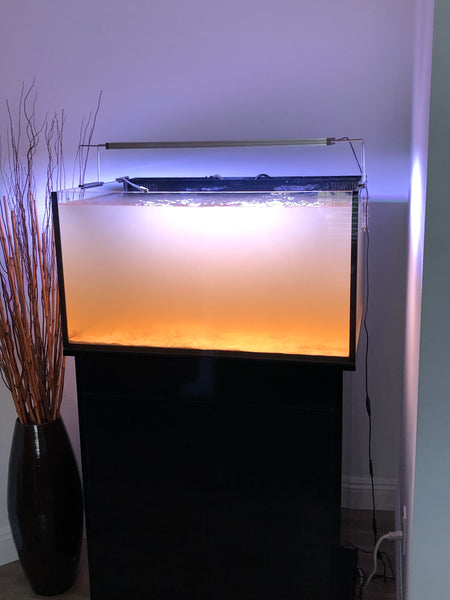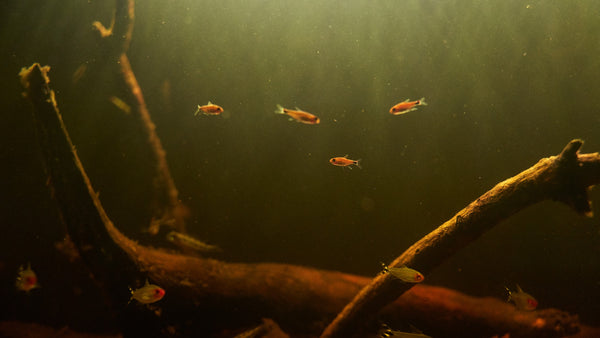- Continue Shopping
- Your Cart is Empty
Startup and beyond...
There is something exciting about the earliest days of an aquarium, isn't there? After the initial "construction" work is done, there is that time when you sort of look back and allow the "dust to settle..."
And that's just the very beginning...

The "startup phase" is NOT those first hours after you fire up the tank. Nope- it's a much longer affair...Like, maybe the first 6 weeks or so of the aquarium's existence. Yeah, these are the critical parts of the "startup" of an aquarium.

I mean, there is a LOT of change that happens in a brand new tank over the first six weeks of its existence!
That's not to say that the very first moments of a new tank aren't the most exciting and even challenging, of course. There are problems to solve, adjustments to make, and observations to note.

I find the most "stressful" part of setting up a new aquarium to be those initial 24 hours after you set it up. You know, that time when the focus is on making sure that everything is up and running fine. It's also an "educational" time for you as a hobbyist, when you can sort of familiarize yourself with the way your aquarium operates.
It's a time when you learn to "read" your new tank...to recognize every sound the tank makes...to know what is a "normal" sound versus one that you don't want to hear. It's a time to make sure that the operating level of the water is optimal. A time to "dial in" your heater, pumps, etc.
And we tend to obsess over our tanks at this time, don't we?
Okay, at least I know that I do!
You know, making sure everything is running correctly- that tank isn't leaking...A time to make sure that the plumbing connections are tight, light and heater settings are correct, etc.
But that's just the "mechanics" of your aquarium.
Getting those things buttoned up is important...And then the fun really begins.
You know, making the tank come alive.
Bringing it from a clean, dry,"static display" to a living, breathing microcosm, filled with life. This, to me is the most exciting part!

And how do we usually do it? I mean, for many hobbyists, we've been more or less indoctrinated to clean the sand, age water, add wood, arrange plants, and add fishes. And that works, of course. It's the basic "formula" we've used for over a century.
And it works...
Yet, I'm surprised how we as a hobby have managed to turn what to me is one of the most inspiring, fascinating, and important parts of our aquarium hobby journey into what is more-or-less a "checklist" to be run through- an "obstacle", really- to our ultimate enjoyment of our aquarium.

When you think about it, setting the stage for life in our aquariums is the SINGLE most important thing that we do. If we utilize a different mind set, and deploy a lot more patience for the process, we start to look at it a bit differently.
I mean, sure, you want to rinse sand as clean as possible. You want make sure that you have a piece of wood that's been soaked for a while, and..
Wait, DO you?
I mean, sure, if you don't rinse your sand carefully, you'll get some cloudy water for weeks...no argument there.

And if you don't clean your driftwood carefully, you're liable to have some soil or other "dirt" get into your system, and more tannins being released, which leads to...well, what does it lead to?
I mean, an aquarium is not a "sterile" habitat.
The natural aquatic habits, although comprised of many millions times the volumes of water that we have in our tanks- are typically not "pristine"- right? I mean, soils from terrestrial geologic activity carry with them decomposing matter, leaves, etc, all of which impact the chemistry, oxygen-carrying capacity, biological activity, and of course, the visual appearance of the water.

And that's kind of what our whole botanical-style aquarium adventure is all about- utilizing the "imperfect" nature of the materials at our disposal, and fostering and appreciating the natural interactions which take place in aquatic habitats. Understanding that descriptors such as "crystal clear" and "pristine" only apply to some aquatic habitats, and that there is real beauty in all types of aquatic habitats.

Indeed, the real "magic", in many instances, occurs in the more murky, turbid, not-so-crystal-clear waters of the world. And if we understand and accept this, we're likely to start our aquariums with a bit less concern over absolute sterile perfection.
We can embrace the mindset that every leaf, every piece of wood, every bit of substrate in our aquariums is actually a sort of "catalyst" for sparking biodiversity and yes- a new view of aesthetics in our aquariums.

I'm not saying that we should NOT rinse sand, or soak wood before adding it to our tanks. What I AM suggesting is that we don't "lose our shit" if our water gets a little bit turbid or there is a bit of botanical detritus accumulating on the substrate. And guess what? We don't have to start a tank with brand new, right-from-the-bag substrate.
Of course not.

We can utilize some old substrate from another tank (we have done this as a hobby for years for the purpose of "jump starting bacterial growth) for the purpose of providing a different aesthetic as well.
And, you can/should take it further: Use that slightly algal-covered piece of driftwood or rock in our brand new tank...This gives a more "broken-in look", and helps foster a habitat more favorable to the growth of the microorganisms, fungi, and other creatures which comprise an important part of our closed aquarium ecosystems.
In fact, in a botanical-style aquarium, facilitating the rapid growth of such biotia is foundational.

It's okay for your tank to look a bit "worn" right from the start.
In fact, I think most of us actually would prefer that! It's okay to embrace this. From a functional AND aesthetic standpoint. Employ good husbandry, careful observation, and common sense when starting and managing your new aquarium.

But don't obsess over "pristine." Especially in those first hours.
The aquarium still has to clear a few metaphorical "hurdles" in order to be a stable environment for life to thrive.
I am operating on the assumption (gulp) that most of us have a basic understanding of the nitrogen cycle and how it impacts our aquariums. However, maybe we don’t all have that understanding. My ramblings have been labeled as “moronic” by at least one “critic” before, however, so it’s no biggie for me as said “moron” to give a very over-simplified review of the “cycling” process in an aquarium, so let’s touch on that for just a moment!

During the "cycling" process, ammonia levels will build and then suddenly decline as the nitrite-forming bacteria multiply in the system. Because nitrate-forming bacteria don't appear until nitrite is available in sufficient quantities to sustain them, nitrite levels climb dramatically as the ammonia is converted, and keep rising as the constantly-available ammonia is converted to nitrite.
Once the nitrate-forming bacteria multiply in sufficient numbers, nitrite levels decrease dramatically, nitrate levels rise, and the tank is considered “fully cycled.”

So, in summary, I suppose that you could correctly label your system “fully cycled” as soon as nitrates are detectible, and when ammonia and nitrite levels are undetectable.
This usually takes anywhere from 10 days to as many as 4-6 weeks, depending on a number of factors. In my experience, there are certainly some “cheats” you can use to speed up the process, such as the addition of some filter media or sand from a healthy, “mature” aquarium, or even utilizing one of the many commercially available “bacteria in a bottle” products to help build populations of beneficial bacterial populations. I hate cheating...but I kind of like some shortcuts on occasion!

So we have at least, for purposes of this discussion, established what we mean in aquarium vernacular by the term “fully cycled.”
With a stabilized nitrogen cycle in place, the real evolution of the aquarium begins. This process is constant, and the actions of Nature in our aquariums facilitate changes.
And our botanical-style systems change constantly.
They change over time in very noticeable ways, as the leaves and botanicals break down and change shape and form. The water will darken. Often, there may be an almost "patina" or haziness to the water along with the tint- the result of dissolving botanical material and perhaps a "bloom" of microorganisms which consume them.
This is perfectly analogous to what you see in the natural habitats of the fishes that we love so much. As the materials present in the flooded forests, ponds, and streams break down, they alter it biologically, chemically, and even physically.

It's something that we as aquarists have to accept in our tanks, which is not always easy for us, right?Decomposition, detritus, biofilms- all that stuff looks, well- different than what we've been told over the years is "proper" for an aquarium. And, it's as much a perception issue as it is a husbandry one. I mean, we're talking about materials from decomposing botanicals and wood, as opposed to uneaten food, fish waste, and such.
What's really cool about this is that, in our community, we aren't seeing hobbyists freak out over some of the aesthetics previously associated with "dirty!"
It's fundamental.

And it's not like we've told ourselves that it's acceptable to not change water, siphon detritus, overstock, or overfeed. Nope. We can still perform excellent regular husbandry routines on botanical-style aquariums. We're still diligent aquarists. And we still might have so-called "dirty" looking water!
And, that's kind of what Nature wants, right?
Always remember that Nature plays by her own rules, developed over eons. When we accept Her rules, embrace Her aesthetics...and make a mental shift to something that the rest of the world might call messy- we can truly appreciate its real beauty.
We have made a collective mental shift. We've evolved, right along with our aquariums.

And it all begins right at the startup.
Stay patient. Stay ambitious. Stay curious. Stay excited. Stay diligent...
And Stay Wet.
Scott Fellman
Tannin Aquatics










Scott Fellman
Author